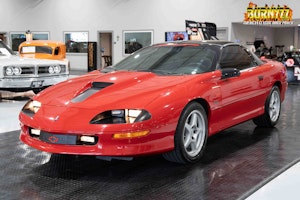Media | Articles
5 Tools That Often Get Misused
Tools are the items and objects we use to complete the tasks we desire to do. At one point in human history we likely only had three tools: a pointy rock, a sharp-edged rock, and a blunt heavy rock. With those three things an industry was born, and it’s one that is today closely linked to the automotive world. We need a lot more tools than those primitive three to get any project done these days, but sometimes we might have the right tool and still decide to use the wrong one. Here are five examples.
If Not Pry Bar, Why Pry Bar Shaped?

Screwdrivers can be precision instruments. They can also be the closest thing to your hand when you need to lever two pieces apart, and oh boy, is it tempting to take that flat-blade screwdriver and shove it in there, maybe even tapping the end of the handle with a hammer to help things along.
Sometimes that works fine, but why take the risk with your tools? Screwdrivers were designed for turning forces and thus it is surprisingly easy to bend the shank or fracture the tip once you start using them in a freestyle manner. If you’re unable to find a pry bar or lever of the appropriate size for your projects, designating one tool for that task is the next best option, though still only half a step short of tool abuse. I have an old damaged flat blade screwdriver that is only used wrong these days. But most screwdrivers do not have shanks that extend completely through the handle, so be advised that any attempts to use a screwdriver like a chisel are likely to break the handle.
Designed to Twirl, Forced to Fight


Sockets are great at removing hardware, but the location of said hardware often means putting those sockets on some type of extension. These simple straight bars have both male and female ends for attaching a ratchet or breaker bar on one end and the socket on the other. That shape also makes them a perfect general-use punch. The broad tip doesn’t focus force much and makes an extension just too perfectly suited for driving out large bolts like those found on suspension hardware. It’s a tool that was designed and born to spin like a ballerina, but often has to pull duty on the offensive line as well.
“The Claw”

At some point a hammer is a hammer, but using a claw hammer under the hood just feels so wrong. Ball-peen hammers are much better for working in the tighter confines of an engine compartment, compared to claw hammers that were designed for framing houses. Ball-peen and dead-blow hammers are likely the most popular for automotive use and come in a range of sizes that help persuade stuck parts and hardware, but that doesn’t stop many people from grabbing what is handy, and I guess we can’t blame them.
Marketplace
Buy and sell classics with confidence
OBD Scan Tools

How could you use an OBD scan tool wrong? Well, I use mine to clear the check engine light and not much more, which quite honestly is massive underutilization of the surprisingly powerful diagnostics abilities that come with a $12 scan tool. I simply don’t want to see the check engine light, because I know the “clogged catalyst” that trips the light isn’t actually being clogged. The problem is that I don’t drive long-enough trips in the winter, and the ECU is putting in additional fuel to try to help the engine warm up and run smoothly, thus the O2 sensors are seeing readings the computer doesn’t like. So I use my scan tool to remove the code and nothing else.
It’s a Lever off the Jack, Too!


Hydraulic floor jacks make lifting our project cars easier than ever. Once the car is up in the air, there is usually (always? without fail?) some large bolt or nut that needs removed, and of course it’s somehow stuck far tighter than the torque spec would suggest. So it’s time to get archaic. Even my two-foot breaker bar is not enough at times, and that’s when the jack donates its handle to create the lever long enough to move most anything. If you’re tempted to use this trick, be careful, the force can be enough to easily strip the teeth inside a ratchet, so it’s best to stick to using a breaker bar. And even then, be sure to have solid socket engagement and a clear path for the long lever to swing in without hitting something else.



















Anything works as a hammer
I think the most common mis-use is: Using a Philips screw driver on JIS screws. Most people don’t know there’s a difference. If you care, look it up.
I’m sure we’ve all been initiated to the bad choice club.
anyone who’s skinned their knuckles, on a slipped wrench etc.
Watching the crimson running from the wound, mixing with dirty grease, -pausing briefly to wrap some electrical or duct tape around what’s left of the skin on your quivering hand,
-just gotta finish this project off, I’ll take care of the wound later…
Ps: I miss sears with their lifetime warranty on craftsman tools. I remember their bin of shame, full of dispatched tools. Little metal soldiers who gave their lives to help us quickly win the battle.
Exchanging destroyed chisels (screwdrivers) cracked sockets -used on impact drivers or stripped rachets.
All usually caused by grabbing the first tool you can see when reaching into the toolbox.
Damaged socket extension bars can grind the mushroom shape off or? Hell, just take it back to sears.
It’s all worth it when you slam the hood knowing you just fixed the problem in record time,
Such a feeling of accomplishment
Never thought of it but I have a feeling the next time I need a breaker bar I will be robbing the jack handle with a smile on my face
Removing Harmonic Balancer with a cheater wedged to the floor and bump the starter! Used a pair of Vice Grips as a kick starter on a Bultaco for years……
I am a believer that too much is not enough. Where’s the 2 lb hammer?
WOT !! only 2 lb a gentle persuader is 28lb in the marine ( ship )world , My senior fitter ( the only one who can wield the thing ) has a 90 lb long handled to shock release propellors.
I remember using the handle of my floor jack for a bar to check ball joint play. When I removed the bar, the part it was inserted into then went up and into position to not allow the bar to be reinserted.
I pushed on the star shaped gear to lower the jack. When I did this, my hand ended up where it should never have been, and I tore my pinky finger open and ended up at the hospital for stitches.
That was when I ended up shaking hands with danger. Bad move…
If you have never seen the video from the seventies called “Shaking Hands with Danger”, you might want to check it out.
I now have an old section of pipe I use just for this purpose. It also works as a cheater bar to get more leverage out of my breaker bar. I also now have a permanent scar on my finger.
Very good article. Having misused all of the above including the vice grips, the article is very appropriate.
My Dad was a machinist who worked in a gear works and for a while I worked there too on the hardening furnaces. I have many of his tools in his tool box and I’m reminded of him whenever I use any of them. They are some of my prized possessions, especially his ball peen hammer.
I would like too see all slotted fasteners removed from this earth, that being said I have a few different size slots that with the help of a bench grinder I have made into tooling for a specific job, on the punch side I have collected different size steel flat stock, rod and square tube that I have ground to accommodate most punch requirements. Drill press, bench grinder, wire wheel and vice are the best investments.
I used a sawzall this past Christmas to carve the bird. It was massy but the nasty job was done quickly. I also used a long, 1/4″ extension to mix the drinks.
FYI, the diagnostic trouble codes (DTCs) for catalytic converters has Nothing to do with the converter being plugged nor restricted. It is for the converters no longer having the ability to effectively convert the harmful emissions gasses: CO converted to CO2, Hydrocarbons into Water and Carbon Dioxide.
The DTCs for the failed converts are P0420 & P0430. If these codes are set and the converter is proven to be bad, the next step is to find out what killed the converter. If the converter is setting these codes, the converter can be hit by hand while listening for the internal components rattling (broken cat). The next step to verify the converter is bad is to perform a temperature test while the converter is at full temperature and a richness is induced to verify its condition. A good converter will increase from the inlet to the outlet of the catalytic converter. If the outlet is cooler than the inlet, that indicates a problem with the converter, including but not limited to being hollowed out.
Converters do fail in such a way that they break and/or become restricted, but to the best of my knowledge, there is no code for that.
You left out the crescent wrench and the channel locks, in my early years stripped many a bolt with a loose crescent wrench and rounded many with channel locks since I was too lazy to crawl out from under the car and get the right tool.
I have in my tool box an interesting wrench, trade name “Adjust A Box.” It’s an adjustable wrench with two L-shaped jaws (vs flat), allowing the user to grip four flats on the bolt/nut vs two. I bought it back in the early 60s when metric wrenches were difficult to find. Works very well when you find a weird size bolt–like Whitworth on old British cars and nothing you have, SAE or Metric–will fit.
I have done many of these. Who hasn’t chipped the end off a cheap screwdriver trying to pry something open?
As a plumbers apprentice, I remember my instructor saying in a calm, monotone voice. “Never use your pipe wrench as a hammer… Or at least, never let anybody see you doing it.”